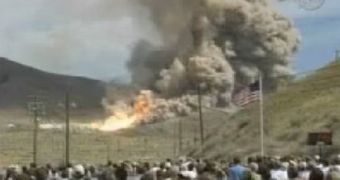After being postponed a couple of weeks ago on account of a minor glitch on a secondary system, the first full-scale burn of DM-1, the motor that will power up ARES I's five-segment first stage, took place yesterday. The event, which was witnessed by many onlookers, took place at a Promontory, Utah-based facility, belonging to NASA's main contractor for DM-1, Alliant Techsystems (ATK). The burn began at 3 pm EDT (1900 GMT), and lasted for exactly 123 seconds, the same amount of time it would be required to burn in case of a real launch.
“After witnessing what we just saw, it's pretty easy to become speechless. With this test, we have taken lessons learned from many years of experience in solid rocket motor development and have built on that foundation,” ARES Projects First-Stage Manager Alex Priskos, from the space agency's Marshall Space Flight Center, in Huntsville, Alabama, says, quoted by Space. This is the second time managers have attempted firing the 154-foot (47-meter) -long first stage, with the first attempt having been stopped on August 27th by a fuel valve in an auxiliary power unit.
DM-1 (first-stage development motor) is a much stronger engine than most on the rocket market today. It is capable of generating a maximum of 3.6 million pounds of thrust, which is about 24 percent more power than that of one twin Shuttle solid rocket booster. It is managed by the ARES Projects division, located at the MSFC. Other related delivery systems under development, or proposed at NASA, are the ARES V heavy-lift rocket and the ARES IV.
A successful ARES I test will now hopefully assure critics that Project Constellation is on the right track, and that the 2015 deadline for its maiden flight can be respected. This becomes even more important now, as the White House-appointed NASA review panel is seriously considering dropping ARES I out of Project Constellation altogether. There is still much work to be done, especially on the Orion Crew Exploration vehicle and on the ARES V heavy-lift rocket, which both depend on ARES I. Controversies are now raging on as to whether this is the best course of action for the agency to take.

 14 DAY TRIAL //
14 DAY TRIAL //